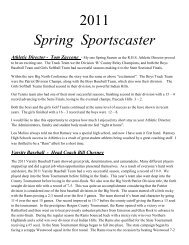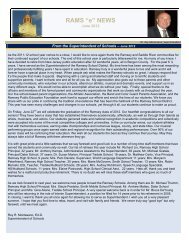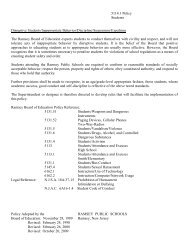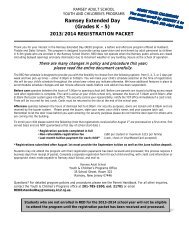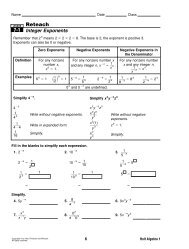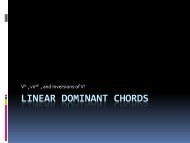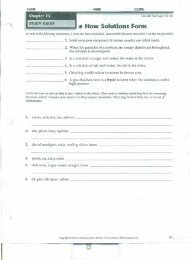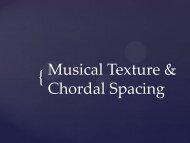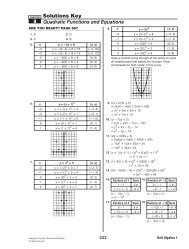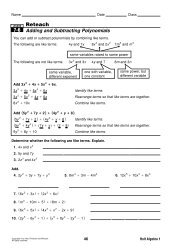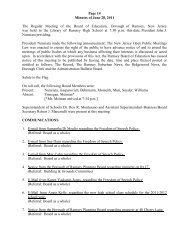Melodic Figuration and Dissonance â Part 1
Melodic Figuration and Dissonance â Part 1
Melodic Figuration and Dissonance â Part 1
Create successful ePaper yourself
Turn your PDF publications into a flip-book with our unique Google optimized e-Paper software.
Embellishing Tones
• Accented Passing Tone (AP)<br />
• Prepared <strong>and</strong> resolved by step<br />
• Tend to resolve downward on the offbeat<br />
• Fig 7.14B<br />
• Accented Neighbors (AN)<br />
• Prepared <strong>and</strong> resolved by step on the offbeat<br />
• Very uncommon<br />
• Fig 7.15<br />
• Suspension (S or susp.)<br />
• Accented dissonance held over from the previous beat <strong>and</strong> resolved by step<br />
• Categorized by the intervallic relation with the bass note<br />
• Consists of 3 parts:<br />
• Preparation – usually as at least as long as the suspended note<br />
• Suspension <strong>Dissonance</strong> – on the beat or on a stressed beat<br />
• Resolution – stepwise downward to a consonance on the offbeat
• Accented Incomplete Neighbors (AIN)<br />
• Always approached by leap <strong>and</strong> resolved by step<br />
• Appoggiatura applies to this figuration<br />
• Appoggiatura is an accented melodic dissonance resolved<br />
by step<br />
• this term can be applied to (AP) <strong>and</strong> (AN)
• Dissonant embellishment that is approached <strong>and</strong><br />
resolved by leap (fig. 1)<br />
• Accented dissonances that resolve by leap are<br />
extremely rare as well (fig. 2)
• May sound <strong>and</strong> look like embellishing tones but are<br />
completely consonant to the supporting harmony<br />
• Involve stepwise intervals of 5 th <strong>and</strong> 6 th above the bass<br />
• If with no dissonance they are still remain<br />
embellishing tones<br />
• They should be labeled as passing, neighbors,<br />
anticipations, & escape tones
Passing Tones Neighbor Anticipation Escape Tone<br />
5 6 6 5 5 6 6 5 5 6
• A bass note usually sustained for several measures<br />
• Name is derived from the bass notes played on the organ<br />
• Not entirely a melodic dissonance<br />
• It’s the moving upper voices that create the dissonance<br />
• Inverted Pedal<br />
• Sustained pitch in an upper voice
• Unaccented/Stepwise (US) Embellishing Tones<br />
• Unaccented Passing (P)<br />
• Unaccented neighbouring tone (N)<br />
• Anticipation (A)<br />
• Unaccented/Leaping (UL) – Incomplete Neighbors (IN)<br />
• Escape Tone (E)<br />
• Leaping Tone (LT)<br />
• Double Neighbor (DN) or changing tone (CT)<br />
• Accented/Stepwise (AS) Embellishing Tones<br />
• Accented Passing Tone (AP)<br />
• Accented Neighbor (AN)<br />
• Suspension (S or susp.)<br />
• Accented /Leaping (AL) – Accented Incomplete Neighbors (AIN)<br />
• Appoggiatura – if it resolves by step, an AP, or an AN<br />
• AIN approached <strong>and</strong> resolved by leap is a FREE TONE
NCT Approached by Left by Metric Position<br />
Passing Tone Step Step (same direction) Weak<br />
Accented PT Step Step (same direction) Strong<br />
Neighbour Tone Step Step (opposite direction) Weak<br />
Accented NT Step Step (opposite direction) Strong<br />
Anticipation Step Repeated Note Weak<br />
Escape Tone Step Leap (usually opp. direction) Weak<br />
Appoggiatura Leap Step (usually opp. Direction) Strong/Weak<br />
Suspension Repeated Note Step (down to resolution) Strong<br />
Retardation Repeated Note Step (UP to resolution) Strong



